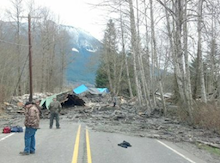After he wrote the first weather-related story about the mudslide that swept over a Snohomish County neighborhood on Saturday, March 22, Seattle Times reporter Ken Armstrong wanted to know about the history of that hill.
He started searching. Was there really no sign that this could happen, as officials told the public?

- This photo provided by the Washington State Patrol shows the aftermath of a mudslide that moved a house with people inside in Snohomish County on Saturday March 22. (AP Photo/Washington State Patrol)
Soon, Armstrong, who won a Pulitzer for investigative reporting in 2012, found a report that mentioned a slide from 1967, on a hill that he thought might be the same. That report was filed in 1999 with the U.S. Army Corps of Engineers. Armstrong found the author of that report, Daniel Miller, and met with him. Miller had six manila folders in his basement full of reports about the history of that hill.
“That’s really what helped tie it together,” Armstrong said in a phone interview with Poynter.
And, he found, there had been mudslides on that hill in 1949, 1951, 1967, 1988 and 2006.
In their coverage of the March 22 mudslide that killed 36 (8 people are still missing,) The Seattle Times used tools they’ve built up over time, from a newsroom intranet with searchable databases to staff who are computer-assisted-reporting specialists. They used those databases to find and confirm the identities of the victims, told narratives of the people involved, and through all that, they included watchdog reporting in their breaking news.
“People are hungry for context,” Armstrong said. “They want to know what happened. They also want to know why it happened.”
The Times won a Pulitzer in 2010 for breaking news coverage, and another in 2012 for investigative reporting.
“With the Oso mudslide coverage,” said investigations editor Jim Neff in an e-mail, “I would argue, we combined them both.”
In addition to their investigative reporting, here’s a look at some of the work the Times produced while covering the slide.
Piecing together the puzzle
The Times has “deep expertise in geo-mapping and had access to layers and layers of statewide maps and data, through Justin Mayo and others,” Neff said of reporter Justin Mayo.
That was vital in the Times reporting, as they tried to piece together the history of the hill and the role that logging may have played in the slide. Armstrong got a tip, he said, that the state may have been using a map with outdated boundaries to regulate logging on the hill where the slide occurred.
He was able to get a map with 1997 boundaries, which was not digitized, and Mayo was able to digitize it and match it up with the outdated 1988 map the state was using.
“Because of that, we were able to show they had they been using the most recent map, clear-cutting would have been restricted,” Armstrong said.
State regulators have been using outdated boundaries to restrict logging above the Snohomish County slope that collapsed March 22, failing to incorporate newer research that would have protected a swath of land that wound up being clear-cut, according to a Seattle Times analysis of documents and geographical data.
Because trees intercept and absorb water, removing them can contribute to the risk or size of a landslide by increasing the soil’s saturation, according to geological reports. The impact can linger for years.
Taking care
The Seattle Times combined watch dog reporting with their breaking news, but they also wrote about the people involved, said Jim Simon, deputy managing editor, in a phone interview with Poynter.
The human drama of the slide was both large and intimate for the people and community impacted, and reporters and editors were careful with their process in identifying the victims, Simon said. They had to have confirmation from a family member, not Facebook, not a neighbor. And they had to get those names right and display that information respectfully, Simon said.
The Times used a gallery of images to help with that, as well as a narrative of the day with contributions from 30 staff members.
Michael Lincoln woke to banging and screams.
He and his wife had been sleeping in on a lazy Saturday morning at his house along state Highway 530. Now his son’s girlfriend, Amy Miles, was pounding on the bedroom door.
“There’s a flash flood!” she screamed. “Or something!”
Miles had packed her boyfriend’s lunch and had watched him drive off to work. She’d been on the porch, about to walk his parents’ yellow lab, Rocco, when she heard a tremendous rumbling and snapping. She looked up and saw Douglas firs falling and breaking and splashes of water shooting up through the woods. Mud and tree limbs raced up the long driveway toward the porch in waves.
“I actually thought it was the end of the world,” she says.
“Taking care with these kinds of stories sort of gets forgotten in this,” Simon said, “but it’s really essential that you don’t magnify the trauma and pain.”







